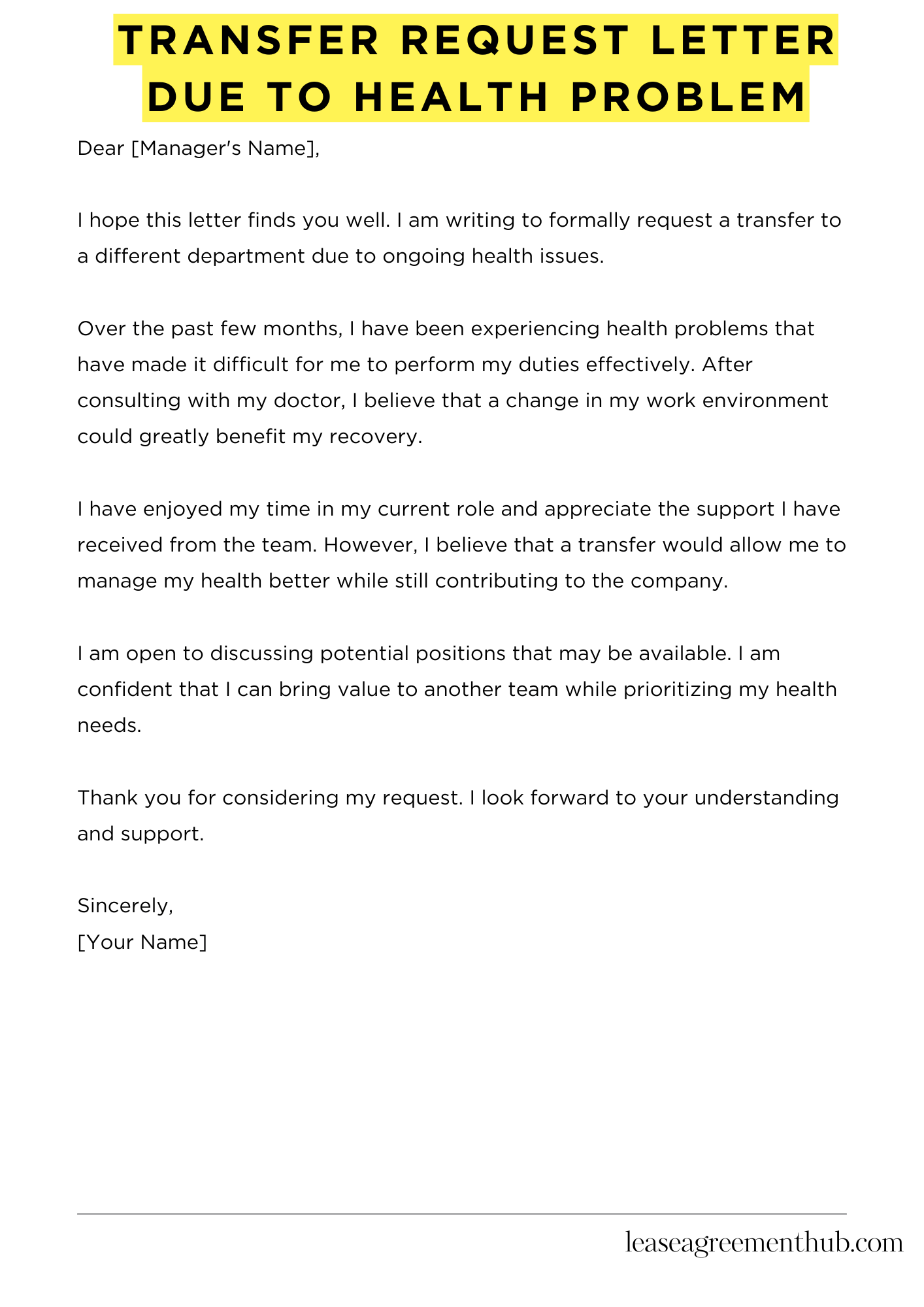A Transfer Request Letter Due To Health Problem is a formal document written by an employee to request a transfer to a different location or position within the organization. Its main purpose is to communicate the need for the transfer due to health-related issues. This letter helps the employer understand the situation and consider the request seriously.
In this article, we will provide various templates and examples of Transfer Request Letters Due To Health Problems. These samples are designed to help you craft your own letter with ease. Whether you need a simple format or a more detailed one, we have you covered.
Writing a transfer request letter can be challenging, especially when discussing health issues. Our goal is to make this process easier for you. With our examples, you can quickly create a professional letter that clearly expresses your needs.
Transfer Request Letter Due To Health Problem
[Your Name]
[Your Address]
[City, State, Zip Code]
[Email Address]
[Phone Number]
[Date]
[Manager’s Name]
[Company’s Name]
[Company’s Address]
[City, State, Zip Code]
Dear [Manager’s Name],
I hope this letter finds you well. I am writing to formally request a transfer to a different department due to ongoing health issues.
Over the past few months, I have been experiencing health problems that have made it difficult for me to perform my duties effectively. After consulting with my doctor, I believe that a change in my work environment could greatly benefit my recovery.
I have enjoyed my time in my current role and appreciate the support I have received from the team. However, I believe that a transfer would allow me to manage my health better while still contributing to the company.
I am open to discussing potential positions that may be available. I am confident that I can bring value to another team while prioritizing my health needs.
Thank you for considering my request. I look forward to your understanding and support.
Sincerely,
[Your Name]

How to Write a Transfer Request Letter Due to Health Problem
It’s never easy to ask for a transfer, especially when it’s due to health issues. But sometimes, a change in your work environment is necessary for your well-being. A well-written transfer request letter can help you navigate this delicate situation. Here’s a guide to help you craft a professional and impactful request.
1. Start with a Clear and Concise Subject Line
Your subject line should immediately inform the recipient of the letter’s purpose. Avoid vague phrases like “Request” or “Important Information.” Instead, be direct and use a subject line like “Transfer Request – [Your Name].”
2. State Your Request and Provide Context
Begin your letter by clearly stating your request for a transfer. Briefly explain the reason for your request. Focus on how the transfer would benefit your health and well-being. For example, you could mention a specific health condition that makes your current work environment challenging or a need for a different work schedule.
3. Highlight Your Contributions and Commitment
Demonstrate your commitment to the company and your contributions to your current role. This helps show that your request is not driven by a desire to shirk responsibility but by a genuine need for a change. You can mention specific achievements or projects you’ve worked on.
4. Express Your Willingness to Collaborate
Show that you’re open to working with the company to find a solution that works for everyone. Be flexible and suggest potential transfer options or adjustments to your current role. This demonstrates your willingness to find a mutually beneficial outcome.
5. End with a Professional Closing
End your letter with a polite and professional closing. Thank the recipient for their time and consideration. Reiterate your commitment to your work and the company. Include your contact information for easy communication.
Remember, your transfer request letter is a chance to communicate your needs and demonstrate your professionalism. By following these steps, you can craft a letter that effectively conveys your situation and increases the likelihood of a positive outcome.
Related: